This is an Olympus iS-2, a 35mm Single Lens Reflex “Bridge” camera, produced by Olympus Optical Co., LTD in Tokyo, Japan starting in 1991. After the manual focus Olympus OM-system, Olympus never made a serious 35mm SLR with auto focus. The Olympus iS series was created to fill that gap in Olympus’s lineup. The Olympus iS-2 was its North American name as the camera was also called the iS-2000 in Europe and L-2 in Japan. A version with a date back called the iS-2 DLX also exists. Despite having a non-interchangeable 3.8x zoom lens, and a design that was quite a bit different from a traditional SLR, the iS-2 has a long list of features, including a macro mode, an advanced pop up flash with two different strobes, a full suite of flash sync and exposure modes, and a motor drive that could shoot up to 2.5 frames per second. As far as bridge cameras go, the Olympus iS-2 was quite a capable example of the genre.
Film Type: 135 (35mm)
Lens: 35 – 135mm f/4.5 – 5.6 Olympus Zoom ED coated 16-elements in 15-groups
Focus: 2 feet / 0.6 meters to Infinity, Macro Mode 1.3 feet / 0.39 meters to Infinity
Viewfinder: Fixed SLR Pentaprism, 85% Field of View, 0.75x Magnification
Shutter: Electronically Controlled Vertical Focal Plane
Speeds: B, 15 – 1/2000 seconds
Exposure Meter: Coupled ESP TTL Light Meter, Center Weighted, Average, and Spot Metering Modes
Battery: (2x) 3v CR123A Lithium Battery
Flash Mount: Hot shoe plus Dual Strobe Pop Up Flash,
Other Features: Self-Timer, DX Encoding, Auto Film Load, Multiple Exposure and Flash Modes
Weight: 936 grams
Manual: https://cameramanuals.org/olympus_pdf/olympus_is-2_dlx.pdf
How these ratings work |
The idea of a “bridge” camera was to bridge the gap between easy to use point and shoots with more advanced SLRs, hoping to give novice photographers more capable cameras that were still easy to use. While a lot of bridge cameras had strange designs and questionable popularity, the Olympus IS-series seemed to find the right balance of familiarity, advanced features, and good performance. The Olympus IS-2 is a very nice camera that feels like an SLR, but works like a point and shoot. The lens, despite being a rather slow 4x zoom, makes razor sharp images with excellent quality. In addition, the IS-2 has a number of advanced features like a dual range flash, macro ability, full manual control, intentional double exposures, and multiple scene modes not found in many consumer grade cameras. The Olympus IS-2 could be the best beginner’s SLR ever made. | ||||||
| Images | Handling | Features | Viewfinder | Feel & Beauty | History | Age | |
| 2 | 2 | 2 | 1 | 1 | 2 | 0% | |
| Bonus | +1 for an unexpected level of quality and features, more than the sum of its parts | ||||||
| Final Score | 11.0 | ||||||
History
 Olympus has long been well known in the photo industry with a long list of quality cameras and lenses which they had produced. Zuiko lenses adorned some of the best cameras from Leica rangefinders, Aires TLRs, to the company’s own SLRs, rangefinders, and point and shoots. The 1980s saw a swift change from mechanical to electronic cameras, along with the inclusion of more automation, computer circuitry, and lightweight plastics. A state of the art 1980s SLR looked very different from one released 10 or even 5 years earlier.
Olympus has long been well known in the photo industry with a long list of quality cameras and lenses which they had produced. Zuiko lenses adorned some of the best cameras from Leica rangefinders, Aires TLRs, to the company’s own SLRs, rangefinders, and point and shoots. The 1980s saw a swift change from mechanical to electronic cameras, along with the inclusion of more automation, computer circuitry, and lightweight plastics. A state of the art 1980s SLR looked very different from one released 10 or even 5 years earlier.
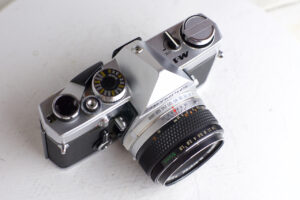
For Olympus, the company had a good run of high quality and well respected 35mm SLRs in the OM series, starting with the original M-1 / OM-1 from 1972 to the more consumer friendly OM-10 series. Olympus made great SLRs with a compact body, good ergonomics, and great lenses.
In the mid 1980s, the hottest topic in the world of 35mm SLRs was auto focus. Companies like Nikon, Canon, and Pentax had already released manual focus SLRs with support for one or two special auto focus lenses with external focus control. These early AF SLRs were clunky, expensive, but they did work. In 1985, Minolta wowed the world with the Maxxum 7000, the world’s first 35mm SLR to feature in-body auto focus control and a whole lineup of AF capable lenses. To accomplish this, they abandoned their earlier manual focus SR mount and created an all new AF Maxxum (later called Alpha) mount. In 1987, Canon did something similar, abandoning their earlier manual focus R/FL/FD mount lenses for a new AF EOS mount.
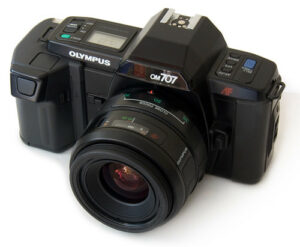
Whether it was intentional or not, Olympus approached auto focus SLRs with caution. Their first model, the OM-77 / OM-707 was released in 1986 and took aim at the novice photographer. Olympus believed that photographers looking for an SLR that could automatically focus wouldn’t be interested in manually focusing their lenses, so all AF specific lenses made for it lacked a manual focus ring. As a consolation, the OM-707 had a feature called “Power Focus” in which a slider on the back of the camera controlled the auto focus lens, manually. Although this did give back some manual control to an otherwise automatic lens, it was not very precise and felt very disconnected to the camera. Further missteps were a lack of compatibility with many OM-system accessories and some lenses.
Compared to other first generation 35mm auto focus SLRs, Olympus’s new camera sold poorly, but rather than respond with a more feature rich and backwards compatible auto focus camera, they went in the opposite direction and released the OM-88 / OM-101, which had an even simpler feature set from the previous model. The new camera only supported Programmed AE without any built in manual control of shutter speeds or aperture, without the purchase of an additional accessory which added those feature back, but an even more curious decision was the release of a couple “Power Focus” only lenses, which could neither be focused manually, but also didn’t auto focus either, unless you used the Power Focus wheel on the back of the camera.
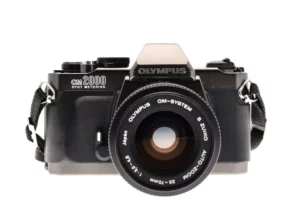
If the OM-707 was a misstep for Olympus, the OM-101 was a complete disaster. Both cameras sold poorly, and tanked Olympus’s reputation in the 35mm market. Although Olympus would release one more interchangeable lens 35mm SLR in 1997 called the OM2000, it had nothing to do with the company’s earlier cameras, and was simply a rebadged Cosina CT-1 Super.
Whether it was a direct result of the failure to successfully enter into the auto focus 35mm SLR marker, or a symptom of problems within the company, by the end of the decade, Olympus would stop releasing new 35mm SLRs and would instead concentrate on simpler point and shoot cameras.
Or at least, that seemed to be the plan until 1990 when Olympus would release a new type of 35mm SLR called the iS-series. The first model in this series was the Olympus iS-1.
Name Variants: Olympus followed a common practice of giving its cameras different names depending on where it was being sold. Other companies like Nikon and Minolta did this too as a way of restricting “gray market” cameras being sold in wrong markets to take advantage of favorable exchange rates. For many mail order camera shops, it was often cheaper to import a new model being sold in another country and sell it than the models being officially offered for sale by their same country’s official distributor. By giving unique names to cameras created for the European, Japanese, and American markets, it would be obvious if someone was importing cameras this way.
For the remainder of this article, I will refer to the US version of each models name since that is where I am from. For models like the iS-1 and iS-2, the European and Japanese names were iS-1000 and L-1, respectively.
The iS-1 was an SLR in the sense that it had a single lens and a reflex mirror, but unlike all other SLRs released up until that point by Olympus, the iS-1 was part of a new category of camera called a “bridge camera”. Bridge cameras were given that name as they were created in the late 1980s and early 1990s to bridge the gap between advanced and consumer oriented cameras, while eschewing standard design and ergonomics. Bridge cameras experimented with new shapes and sizes, introducing advanced features into easy to use, consumer friendly bodies. Models like the soda can shaped Canon Photura to the camcorder shaped Yashica Samurai are all part of this design.
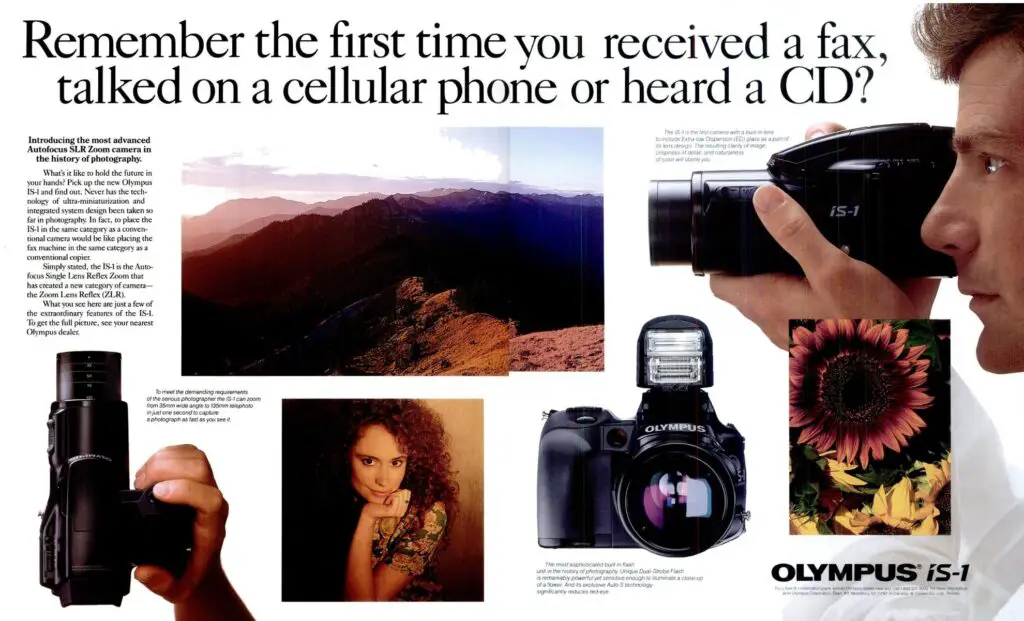
The Olympus iS-1 took a bit more conservative approach than some other companies, but incorporated a large 3.8x fixed zoom lens into an SLR body with a large LCD databack and prominent hand grip on the side. Compared to some of the more outlandish bridge cameras like the Ricoh Mirai, the Olympus iS-1 was both handsome and futuristic at the same time. Its clean design and gentle curves were attractive, while not being intimidating to someone who might have never used an SLR before.
As it would turn out, the iS-1 would prove to be very successful and would launch an entire family of iS series SLRs that would remain in production for over a decade. Olympus would release two similar models called the iS-2 and iS-3 in 1991 and 1992 respectively and would make available all three models for sale at the same time. Starting in 1994, newer models called the iS-10, iS-20, iS-30, and one final model called the iS-21 would be released with smaller bodies, less features, and simpler functionality.

In addition to a futuristic shape that was comfortable to hold and had a great lens, another factor in the lineups success was the large number of advanced features Olympus packed into each model. Although simpler models would eventually be included in the lineup, the single digit iS-1, 2, and 3 models all had a super sharp zoom lens with ED glass elements, each supported a macro mode which could focus down to 2 feet / 0.6 meters, an advanced dual stage pop up flash which could be used at a lower power in macro mode and with more power when shooting objects farther away, a shutter with speeds from 15 to 1/2000 seconds and a 1/100 X-sync, multiple exposure modes including full manual, double exposure, long exposure, and a whole host of other options.
Later models would upgrade the 35-135mm lens to 35-180mm, continuous drive speeds would increase slightly from 1.8 fps to 2.3 fps, filter size would increase from 49mm to 55mm and additional shooting modes would be added.
The choice of a non-removable lens with zoom range from 35-135mm was a calculated move by Olympus as they had found that well over half of all interchangeable lens SLR users never changed their lenses from the standard 50mm lens, and for those that did, very few ever went beyond 35mm or 135mm, so a zoomable lens with those exact same focal lengths was specifically chosen for the camera. Also, by going with a non interchangeable lens, Olympus did not have to bother with creating an all new auto focus mount to replace their aging OM mount, the electronics needed to control the lens could be simplified since the camera never had to adapt to other focal lengths, and without the need for things like a lens flange and any coupling devices needed to communicate between the lens and body, the camera could be built with less parts, and for less money.
I could not find any pricing information for the iS-1 or is-2, but in a short review from February 1993 for the Olympus is-3, the camera carried a retail price of $900, which when adjusted for inflation, compares to $1930 today. Of course, It was unlikely that anyone would have paid that price back then as actual street prices were usually about 25% less than retail, but even at a reduced price, the Olympus iS-series would have been quite an investment for someone who might have never owned an SLR before.
The Olympus iS-1, iS-2, and iS-3 were all available at the same time and shared many of the same attributes. I could not find a contemporary review of the iS-2, but did find this one from December 1999 for the later iS-3 DLX which added a data back to the regular iS-3.
In this short review, it is claimed that Olympus referred to the iS-3 not as a bridge camera, but as a ZLR for Zoom Lens Reflex. In some ads for the camera, such as the one for the iS-1 earlier in this review, Olympus invents the term, which I don’t recall seeing any other manufacturers use.

Nevertheless, the review is very positive, claiming that the marriage of a zoom lens in an easy to use and capable AF body was a good one. The review briefly summarizes the camera’s many features and modes before stating that the 16 element lens produces unusually good images, even going as far as to say that accessory screw on wide angle convertors perform good as well.
Positive remarks were also given to the capable AF system which projects red vertical lines on its subject to help measure distance, calling it “very capable” and saying that the built in flash was surprisingly powerful. The review concludes saying that those with no SLR experience would take to the controls quickly, and that experienced SLR users would have a readjustment period, but that it would be worth it.
A strange phenomenon I’ve noticed when reviewing cameras is that often, the more recently a camera was released, the harder it is to get conclusive facts about its production numbers or timeline. According to a highly detailed page at an Olympus OM fan page, the iS-1, iS-2, and iS-3 were released in 1990, 1991, and 1992 respectively, with the iS-3 still in production until at least 2000 when the website appears to have been last updated. That a review for the iS-3 was published in the December 1999 issue of Popular Photography certainly confirms this timeline, but doesn’t clarify when the camera did cease production.
It also suggests that the relatively long life of the iS-3 and by proxy, the entire series, that these cameras were quite popular. Based on contemporary reviews and my own limited experience with bridge cameras, the Olympus iS-series seemed to hit the right balance of futuristic design, ease of use, well rounded features, and excellent performance.
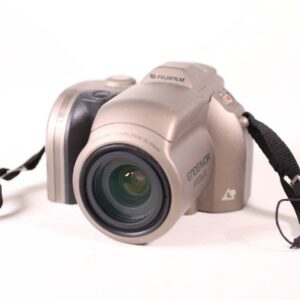
At some point probably near the very end of the 1990s, Olympus would release a camera called the Centurion which shared a similar design to the iS-series except it used Kodak’s then-new Advanced Photo System. A name variant of the Olympus Centurion was also sold by Fujifilm as the Fujifilm Endeavor 4000SL.
Today, the Olympus iS-series is mostly forgotten by collectors and film enthusiasts. For those who do remember them, they knew them as very capable cameras with an excellent lens and long list of features, but for most everyone else, the series simply isn’t old enough to excite most collectors or people getting back into film.
A somewhat ironic legacy of the bridge camera era is that the term was originally meant to bridge the gap between simple point and shoots and higher specification SLRs and semi professional cameras, but in the eyes of history, ended up bridging the end of the film and the start of the digital era. While the term wasn’t commonly used in the digital era, the idea that a camera didn’t have to conform to the same design ethos as previous models definitely permeated the digital era with strange and unusually shaped cameras, many of which had a litany of features with questionable usefulness.
My Thoughts
Aaaah, bridge cameras, that short lived era of photography where established norms of design and ergonomics were thrown out the window. An era in which camera makers used any shape they wanted with various buttons, switches, and knobs placed wherever they saw fit. Some bridge cameras took on an SLR-esque shape with a non-removable zoom lens, but otherwise worked mostly as you’d expect, and others were the Canon Photura.
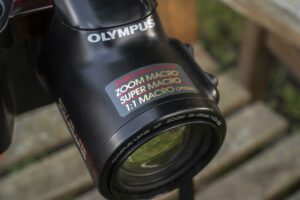
On the weirdness scale, the Olympus iS-2 is rather tame than say, the Ricoh Mirai as it was essentially Olympus’s reboot of an autofocus SLR. For anyone who remembered, Olympus exited the 35mm SLR market with the end of the OM series, only making a few “pseudo-auto focus” cameras like the strange OM-707.
For the iS series, the company took a unique approach and put everything they thought autofocus SLR shooters needed, into a large, but mostly ergonomically correct body. The first time I picked up the iS-2, it definitely felt like a step up from some cheap-o consumer grade autofocus point and shoot. At 936 grams, the camera weighs about what you’d expect a normal auto focus SLR with a kit zoom lens attached would weigh. It is neither too heavy to cause irreparable damage to your neck on long shooting sessions, but heavy enough you’d notice if it was missing from your bag.
A sticker on top of the lens proclaims the camera’s macro features, including a very misleading claim of 1:1 Macro, which requires an additional auxiliary lens not included with the camera. Although the camera does have a built in macro mode, it gets nowhere close to 1:1.
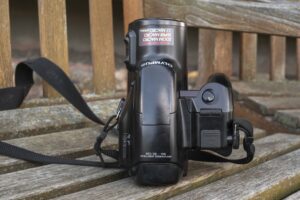
Up top, there’s little to see and what controls are there, their function is pretty obvious. To the left of the prism hump is the camera’s power switch, The cameras does have an auto power off feature which cuts power after 5 minutes, so even if you forget to move the switch to the Off position, you’re not likely to drain the battery much. Off to the right is are two left and right multi-function buttons which are used to cycle through options on the rear LCD. In front of those buttons is a large round shutter release. Below the multi-function buttons is a cover for the flash hot shoe. Although the iS-2 already has a pretty capable pop up flash, you can use an external Speed Lite if you so wish.
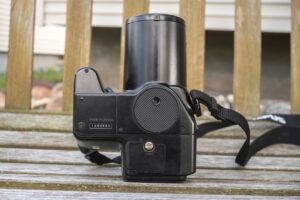
Flip the camera over and on the bottom is a centrally located 1/4″ tripod socket, the door for the battery compartment and a sticker with the camera’s serial number. The battery door has a round lock which is opened using the edge of a coin, a thick screwdriver, or if you’re really brave, your fingernail.

The camera’s left side has a large oval button marked T and W for controlling the zoom function. The letter T means ‘telephoto’ and would zoom into an image, and W means ‘wide angle’ and would be for zooming out. Above and to the right of the zoom control is a switch for manually releasing the pop up flash. The only other thing to see is the permanent attachment for the Olympus neck strap. The opposite side of the camera has only the film door release latch and nothing else.
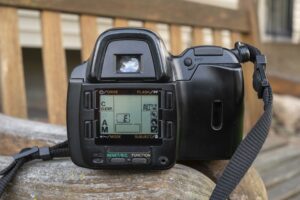
The rear of the camera is where most of the camera’s controls are. A large LCD screen takes up a majority of the area beneath the viewfinder opening and has buttons in each of the LCD screen’s four corners which control various options for drive mode, self-timer, exposure mode, exposure compensation, flash mode, macro, and three different scene modes. Some functions are controlled by simply pressing one of the four buttons with the camera powered on, some require you first press the Function button below the screen. These controls are logically laid out and work as you’d expect, so rather than type a whole bunch of words, if you ever get one of these cameras,. just play with it and you should be able to figure it out.
A couple interesting modes supported by the camera is what’s called Power Focus. This is an option wherein, you can pre-focus your image to a predetermined range, like for example up close or to infinity and lock the focus distance there. Pressing the shutter release only fires the shutter without reactivating the auto focus motor. This would be useful for sports photography where you know where your subject is going to be and you want to eliminate any delay from the auto focus system to get the image at the exact moment you want. There are also three Scene modes for Sports, Portrait, and Night Mode. These all work similarly to the same functions on many other cameras. I’ve always found that the night mode option is the most useful as it allows you to shoot images in low light with long shutter speeds, without activating the flash. One last option is a drive mode for Double Exposure, which allows you to intentionally double expose a single frame of film. This is a feature not often found on fully automatic cameras.

Below and to the left of the function buttons is a recessed manual rewind button for rewinding film in the middle of a roll. On the opposite corner is a socket for an optional remote trigger release that was available for this camera. The iS-2 does not support a mechanical shutter release cable. On the right side, in the middle of the back is a clear window for reading the film type directly off a cassette in the film compartment. Above and to the left of this window is a round button marked “Spot” to engage spot metering. This would be useful when you need to take a reading from a very specific point in your image.

Releasing the door lock on the camera’s right side opens the left hinged film door. The film door itself is actually the entire back of the camera and is rather awkward when opening. To help prevent damage (I assume) the door only opens about 90 degrees and has a rather robust hinge. Film transports from right to left, which is opposite of most 35mm cameras of this era. Loading film should be pretty easy, simply insert a new cassette into the compartment on the right and extend the leader to the red area marked “Film Tip” near the edge, making sure the leader tucks beneath the red piece of plastic in the upper left corner. With the leader properly stretched across the film gate, close the door and the camera will automatically load the film to the first exposure. In practice however, the tight angle of the opened door makes it difficult to get the film leader where it needs to be. This is made worse by film stocks with a lot of curl. I found that when loading film in the camera, I had to be very careful to hold the film very still while closing the door so as to prevent it from moving out of position.
Inside the film door is a large metal film pressure plate covered in divots to reduce friction as film transports through the camera. The Olympus iS-2 supports DX encoded film so there is no need to manually set an ASA film speed when loading film. Film speeds from 25 to 3200 are supported. Intermediate film speeds like Kodak Portra 160 are rounded down to the next lowest speed. I could not find in the camera manual what the default speed is for non-DX coded film, but it is probably 100 like most cameras. Finally, there are no light seals around the edges of the door to go bad, although there is one around the film peep window.

The camera has no other settings, buttons, or switches anywhere else on the camera’s front, or any other sides. A few things worth noting is a focus distance scale printed on top of the lens barrel. As the zoom function is activated, the lens moves forward and back with numbers from 35 to 135 to indicate the focus distance.
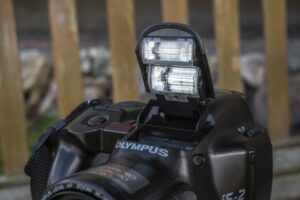
The iS-2 has one of the most advanced built in flashes I’ve ever seen on a camera. Olympus calls their system “Intelligent Variable Power” which comes in quite handy as it can use different power settings for far away and close up shots. With many fully automatic cameras, shooting macro is not possible with a pop up flash as the close proximity to the subject would result in the image being overpowered by the flash. Not so with the iS-2 as its flash can compensate. With ISO 400 film loaded, the flash range is from 2 to 32 feet. The flash can also be used in Super Macro mode as well.
The viewfinder works similarly to most SLR cameras. One minor, but noticeable difference is that the viewfinder eyepiece is ever so slightly angled down, which means you have to tilt your head down to be able to see through it. The angle is nowhere near as extreme as an early Alpa SLR, but does take a little getting used to./
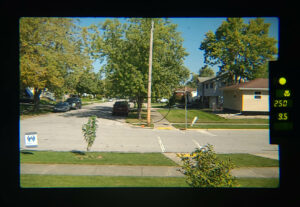
The viewing screen is very bright and allows you to see the composed image, even in low lighting. This is impressive considering the maximum aperture of the zoom lens is f/4.5 at 35mm and f/5.6 at 135mm. Many interchangeable lens SLRs would definitely struggle with brightness when using an f/5.6 lens, but not here. In the center of the viewing screen is a black circle with black rectangle inside. The black rectangle indicates the area in which the auto focus system will measure distance and the circle is the spot metering circle when pressing the Spot button. When not pressing the Spot button, the meter takes an average reading across the entire screen.
On the right of the viewfinder screen are several green LCD screens, two of which indicate selected shutter speed and f/stop, a circle for focus confirmation and various other icons for macro, flash, and EV compensation modes. While I generally prefer SLRs to have their LCD displays at the bottom of the frame, the ones on the side here didn’t bother me. I did struggle to see the entire viewfinder image plus the LCD screens while wearing prescription glasses, but only barely. In use, it wasn’t much of a problem for me.
The Olympus iS-2 is unlike most cameras ever made. On one hand, it is clearly part of the bridge camera era in which traditional design and features were thrown out the window in favor of futuristic and creative designs, yet the Olympus iS-2 manages to still have a level of familiarity to traditional SLRs which shouldn’t alienate fans of the segment, but is still easy enough that someone should be able to pick up the camera without ever looking at the manual and use most of its basic options. In that regard, plus looking at the specifications sheet, the Olympus iS-2 has all the makings of a success, but what kinds of images does it make? Would the camera’s results be consistent with its design? Keep reading…
My Results
Shortly after receiving the Olympus iS-2, I would load in the first of two rolls of film, one of 3 rolls of AGFA Ortho 25 I own. To be honest, I don’t even know why I chose that film as my supply of it is limited, and never having shot this camera before, it was a risk to shoot it in an unproven camera, but to heck with caution I thought and did it. After seeing the results from that initial roll, I wanted to see what it could do with color, so I put in a roll of Fuji 200 and took it with me during some late spring family travels.
What if I were to tell you that I don’t actually show you images from cameras I write reviews for? Instead I just take a Nikon SLR, put on one of the company’s best lenses, shoot a roll or two through that, and then pretend like those images are from the camera I am currently writing about.
Well, I don’t actually do that, but if I did, it is unlikely the images I would have gotten from that camera would have looked much different than what I got from the Olympus iS-2. Before ever picking up one of these strange looking plastic cameras, I had heard the lens was good, but how good could it be? After all, this is a mostly plastic fixed lens point and shoot from the early 1990s, an era that churned out a huge number of similarly average cameras. Come on, the iS-2 couldn’t possibly live up to the standards of a real SLR, could it?
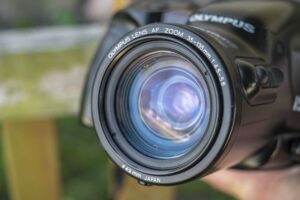
Yes, yes it can, and it did. The images I got from my two rolls of film shot through the Olympus iS-2 were spectacular. This is one of the times where I am very happy I captured a mirror selfie on every roll I shoot so that I can remember which camera shot which roll of film, as I could have just as easily mistaken this for some other expensive top tier SLR I might have shot around the same time.
The images from the 16-element Olympus zoom lens weren’t just better than other SLR zoom lenses I’ve shot, but they rivaled that of many prime lenses too. Sharpness is incredible corner to corner with little to no vignetting or softness near the corners as is common on lesser lenses. Sharpness and contrast on the fine grained AGFA Ortho 25 film was incredible, as was the color accuracy and complete lack of optical artifacts in the color images. One characteristic that is extremely common on zoom lenses in the digital era is chromatic aberrations and purple fringing in which parts of the color spectrum start to break apart on the edges of highlights when zooming. I saw no such anomalies in the color images which suggest that somehow Olympus was able to avoid them, or that perhaps film can’t resolve enough detail to see them (it is probably the latter).
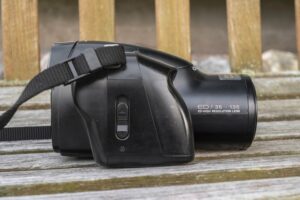
In addition to the impressive image quality, I was also amazed at how useful the macro functions are. While a minimum focus of 2 feet barely qualifies as macro, for a fully automatic point and shoot SLR, it is. Manual focus prime lenses can hit 18, 12, and sometimes even less inches without breaking a sweat, but try that on your average “kit zoom” where 3.5 feet is the norm. Closeups of flowers not only looked razor sharp, but the auto focus system nailed exactly the parts of the flowers I wanted to see. Metering, in addition to everything else was spot on too.
While I didn’t test every function of the camera or push the limits of SLR photography, I used the Olympus iS-2 like how I believe 99% of its intended customer base would have, as an upscale point and shoot with some advanced features, an excellent pop up flash, and an even more amazing zoom lens.
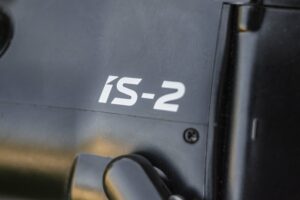
For as much as I can gush about the lens, the camera wasn’t perfect. As I mentioned in the section above, film loading wasn’t the best. For as useful as the large rear LCD screen is on the film door, it causes the film door to be very large and bulky. That it only swings about 90 degrees makes film loading tricky. Perhaps with repetition and very flat film, it is not an issue, but it did turn out to be one of the slightly annoying aspects of the camera.
Another is that the viewfinder has a very slight downward angle to it. While this was likely done for ergonomics, it did cause me on many occasions to have to reposition the camera against my face in order for my eye to see through it. It is minor, and nowhere near as annoying as the steeply angled viewfinder on early Alpa Reflexes, but it did throw me off on occasion.
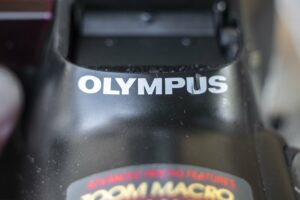
Finally, and again, very minor, but the camera is very large, larger than I’d say a regular SLR with a 35-135mm kit lens would be. While very few SLRs are ever pocketable, this thing won’t even fit in a small purse, this is a “large camera bag” type camera.
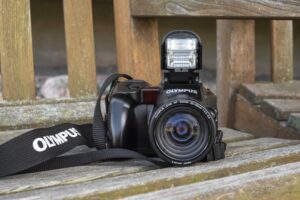
If you’re reading this thinking, “come on, those are nitpicks”, you’re right. I had to go deep into the most minor of issues to find anything wrong with what is otherwise an amazing camera. I’ll go even farther as to say, that for anyone looking to get into film photography, but want a familiar form factor that’s easy to use and delivers great results, without having to learn things like manual focus or manual exposure, the Olympus iS-2, and by association, other cameras in the series, as the perfect film camera for someone wanting to get into the medium.
I feel as though the iS-2 is easy enough and familiar enough to use, with a great lens, great metering system, and flexible focus range, while being new enough that many should still be found in working order, and cheap enough that anyone should be able to pick one up and immediately start getting great results. I don’t know how many people will read this review and immediately go out and get one of their own, but if you do, please let me know in the comments what you think. Did I over hype the camera, or was it everything I made it out to be?!
Related Posts You Might Enjoy
External Links
http://camera-wiki.org/wiki/Olympus_iS-2000_(QD/DLX),_aka_iS-2_and_L-2000
https://esif.world-traveller.org/om-sif/is-series/is-series.htm
https://camarasclassicas.blogspot.com/2011/05/4-olympus-is2-dlx.html
https://www.photo.net/forums/topic/434780-zlr-bridge-camera-or-both/


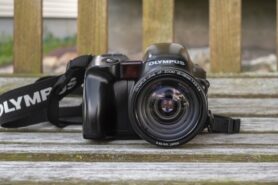
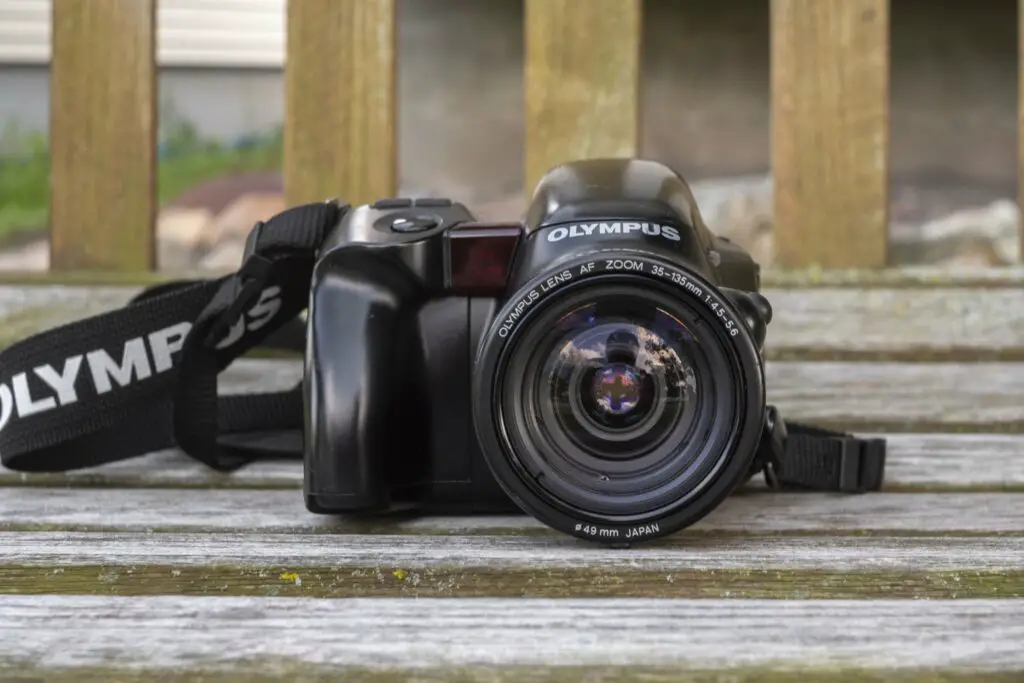
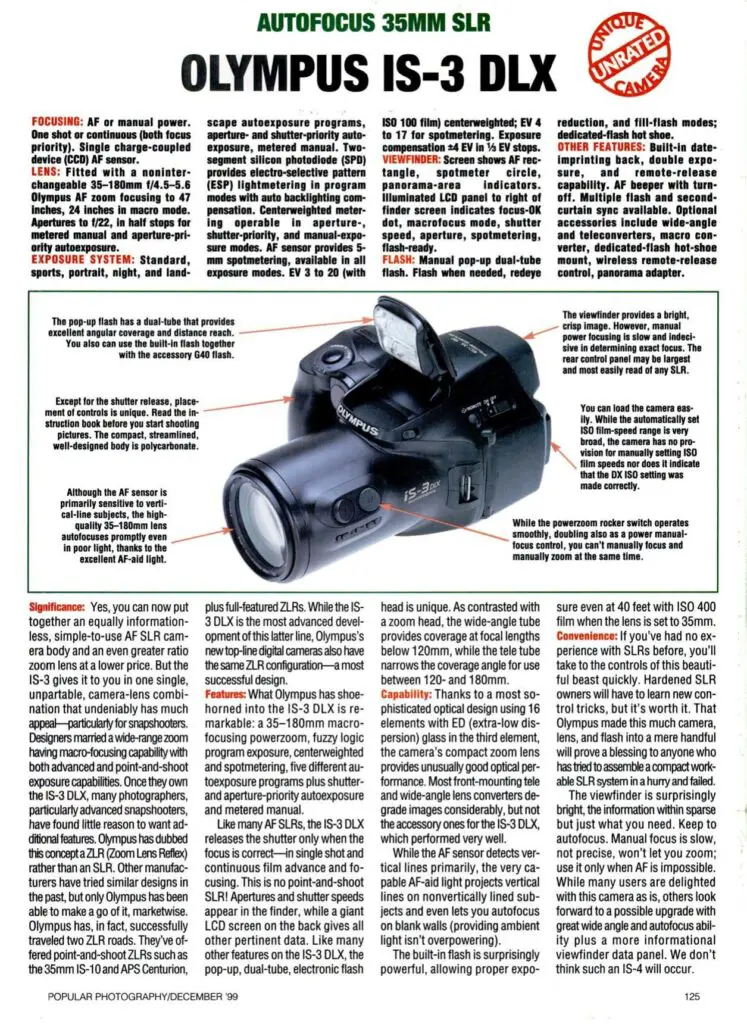






























I have an Is-3000, the european equivalent of an iS-3, L-3. It cost me 29 euros. I also own numerous OM series, XA series cameras, even an FTL (which is excellent by the way) and some of their digital replacements. If I want to go out to shoot film and be sure I will come back with good results I take the iS-3000 every time!
The iS-3000 is slightly different to the iS-2 with a longer reach of it’s lens and different accessory lenses I picked up basically all of the accessories Wide angle converter, tele converter, macro converter dedicated flash (which only fits the iS cameras with a hotshoe) The hotshoe is incompatible with any other flash being slightly narrower than standard and having no centre contact. I paid a total of 82 euros for everything listed including the camera.
I did a review of it on Kosmofoto at https://kosmofoto.com/2021/10/olympus-is-3000-review/ if you are interested.
I am still searching for the manual flash adaptor, the IS/L Multi synchro adaptor – these are like rocking horse droppings – this unit allowed had basically the same options as the G-40 flash, but instead of a flash head it had a standard PC socket on top. they were only produced late in the production run.
The wide angle and teleconverters were especially designed for the camera although it is similar to a T-CON17 the lenses are different and produce a far better image without fringing.
Don’t know about the iS-2 but the iS-3000 defaults to maximum iso if no DX code is present on the film canister, although there is a compensation range of +4 stops to -4 stops
Cracking camera.
Olympus also marketed the Ricoh Marai under the name AZ-4 apparently it appeared in a Batman movie!
I have an IS-3000 (european IS-3) and it is indeed a very nice camera! I have also used the APS Centurion, it has most of the qualities of the 35mm models (albeit the simpler ones, the IS-3000 was really at the top of this range) in a much smaller form factor. However, the APS format does limit the image quality, especially nowadays considering all available film stocks are expired.
In your review you say that the Olympus Centurion and the Fujifilm Fotonex 4000SL have identical bodies but they are quite different. The Fujifilm has a more minimalistic design compared to the dynamic curves of the Olympus.
Mike,
Thank you for reviewing this camera and series. I have collected all the main 1, 2 and 3 versions and use them occasionally. As an early Olympus admirer and user, I came upon this series after shooting with an Olympus SuperZoom Infinity 330 AF, a predecessor of the IS line. I was attracted to the series specs, as well as knowing how Olympus designs follow their own paths to uniqueness. You mention their notable decision to incorporate the zoom lens into the body, but as a general ILC user, I do not like to change lenses in the field with either film or digital cameras, and the internally-sealed mechanisms and lenses are well received as to that effect. Also, I believe that Olympus was an early adopter for the inclusion of ED lens(s) in multi-lens zooms, hence minimizing and controlling the color fringing. I feel a mention should be made of the convoluted film path, of which was the result, I think, for compactness of the design in the rear area, but has received some discussion of it’s actual value in use. As far as design, ergonomics and visual appeal in comparison over a range of cameras in span of three or four decades, this seems to be Olympus’s “Flash Gordon” stage where they just let themselves go with it. Put them next to an analog OM-1 or even a digital OM-D and the difference is obvious that they didn’t have a lot of restraints, which ended up as a good thing, not like, say, the Konica AiBORG. In final assessments, it’s really about the lens in any camera, either by itself, or included in a bridge configuration. And that being said, Olympus made the right decision to put the best they could in the IS series, because, after all, one can’t remove the lens for another.
Hi Mike:
The Olympus iS-3DLX is completely tested in Popular Photography’s July 1993 issue, pages 40-47 and 151. It’s on Google Books. Take a look. I hope you find it interesting.
Thanks
paul1513
“OM-707 had a feature called “Power Focus” in which a thumbwheel” it was a slider – the OM 101 had a thumbwheel.
The OM-88 / OM-101 had no autofocus because of Honeywell suing Minolta for patent infringement. There is an empty space below the mirror box where the AF system was supposed to go, before being removed late into the design. It can only Power Focus lenses, whether they are the two PF lenses made for it, or the OM-101’s AF lenses. The OM-101 can’t AF the PF lenses – they were simplified, cheaper versions of the AF lenses.
“The later iS-3 DLX which added a data back, but is otherwise the same camera.” Same as the iS-3, not the iS-2 as the sentence implies.
“Both the Fujifilm and Olympus cameras shared identical bodies” No, the bodies have very different shapes/styling. It’s not just the color that was different.
“Power Focus. This is an option wherein, you can pre-focus your image to a predetermined range” You can also use the zoom buttons to manually focus – this was the primary intent, not pre-focusing.
“The viewing screen is very bright” because it has no ground glass; it’s just an aerial image. Nice and bright, but nearly impossible to judge focus.
“large rear LCD screen is on the film door, it causes the film door to be very large and bulky.” The film door is bulky because that is where the film is stored as it is wound out of the cartridge.
The first three instances of “it’s” should be “its” instead. The fourth one is okay. Your site is FULL of these distracting errors. “It’s” means “it is” and “its” is possessive.
I should have you proof read my articles! 🙂 Thanks for the corrections, I edited the article and clarified each. 🙂
I picked up an iS-1 at a yard sale for $3 recently and this weird little camera is rapidly becoming a regular addition to my camera bag. It’s so good that I’m thinking of picking up another with the wide and tele converters just to have a spare My main nitpick is that it’s not a very good night photography camera, for which my Electro 35 GSN with its fast glass is far more suited. The autofocus is also a little slow and center weighted metering tends toward overexposure even in bright sunlight. But the images it produces are very sharp and I was pleasantly surprised by the fact that it will allow you to shoot fully manual. A good camera for hiking with friends and family when I don’t want to slow everyone down or carry around an additional 10 lbs of medium format gear.
Taylor, I suggest you look for a Samsung ECX-1. Easy to find on The Bay in NM condition for $20. This unknown gem has a razor-sharp zoom lens, programmed automation, and is a lot more compact than any of the Olympus IS models. (Hat tip to Peggy at CameraGoCamera for pointing me to this camera.)